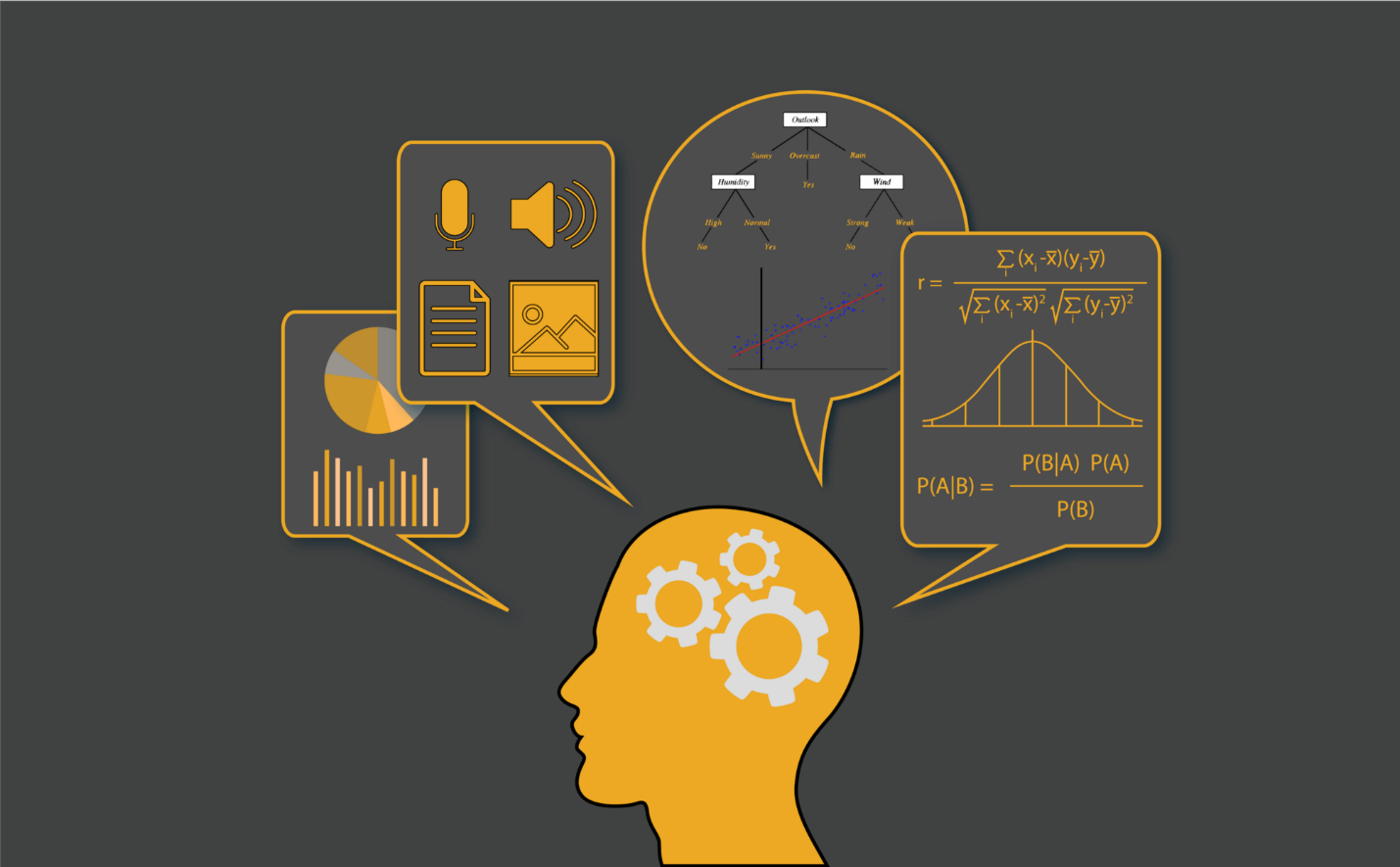
For eCommerce businesses, face-to-face interactions with clients are almost inexistent. Clients make their orders online, make payments through mobile money transfer platforms, and checkout without any human interaction. To make these “invisible” clients happy, eCommerce businesses have to leverage machine learning applications and deep learning to understand who their ideal customers are. It is through knowing who the ideal client is and their pain points that businesses are able to personalize their services and optimize the customer experience.
Understanding Machine Learning
Machine Learning (ML) is a branch of Artificial Intelligence (AI). For starters, AI technology has the ability to sense, predict, reason, adapt, and exhibit any human behavior or intelligence with respect to big data. As a subset of AI, ML trains machines and computers to use algorithms or programs to recognize trends and patterns in raw data and then make sense of those patterns. The more data an algorithm analyzes, the more “knowledge” it accumulates, and the more effectively it applies that knowledge to new data sets. Machine algorithms work in three main ways:
- Supervised algorithms: These algorithms use classified and labeled examples from their past knowledge to analyze current data patterns and predict what might happen in the future.
- Unsupervised algorithms: Instead of relying on specified examples to make predictions, these algorithms crawl through data and draw new, independent inferences. They identify patterns and structures within data and create new knowledge.
- Reinforcement algorithms: These algorithms use trial and error to test different possible outcomes based on different lines of action within a given data set. They, therefore, help eCommerce businesses to pick the most appropriate lines of action in order to achieve the most desired results in the future.
How Is Machine Learning a Goldmine For eCommerce Businesses?

Online shopping gives shoppers more convenience than physical shopping and offers a wide range of choices in terms of products, sellers, quality, and pricing. It’s such obvious benefits that enabled online businesses around the world to make e-retail sales to the tune of 5.2 trillion U.S. dollars in 2021 alone. It’s for the same reason that anyone would expect the eCommerce marketplace to grow consistently through the foreseeable future. But then, a bigger marketplace comes with higher competition from more established eCommerce platforms. Customer preferences and demands also get more complex as the client base widens. That’s where machine learning comes in.
Machine learning assists eCommerce businesses to understand their customers better, serve them better, and gain a competitive edge over competitors. It does this in many ways, among them:
- Product recommendation
Thanks to AI, eCommerce websites can now collect user activity data for their entire online traffic and create a database for each customer. Machine learning algorithms then comb through these databases and understand the taste and preferences of each customer, the pages & subpages they like, their purchase power, etc. They can even go down to the specifics such as a user’s location, favorite color, social media usage, etc. This wealth of knowledge enables product recommendations on your website and helps your eCommerce business in so many ways:
- Product recommendation increases impulsive buying, conversions, and revenue.
- Accurate recommendations save time for clients and boost their satisfaction levels.
- The ML algorithms auto-segment customers who share common identifiers, e.g. people living in the same/similar neighborhoods, age mates, or people who share the same cultural or religious beliefs. Auto-segmentation allows the algorithms to predict the needs and preferences of a large group of people based on the needs and preferences of one member of the group.
- Personalized recommendations will help you predict the future demand for specific product categories. Machine learning algorithms will tell you which trends will rule in the near future, which products you need to restock, and the changes you might want to make in your inventory to maximize customer satisfaction. This will help meet client needs and trends easily, increasing customer retention and revenue.
- Clients sometimes don’t have the right words to describe what they need when they land on your website. Machine learning has natural language processing features that give clients smart search results even when they type vague queries in the search bar.
- Machine learning systems can use their image recognition properties to process images and learn customer behavior from the images they share online. If you’re an online clothing store, for example, ML can study a user’s preferences in terms of color, brand, and so on. That allows the system to effectively categorize users and recommend products that are useful to the customer’s online persona.
- Predicting conversion probability
Machine learning will tell you the likelihood of a particular user returning to your platform and the purchases they might make. Through future lifetime value prediction (LTV), machine learning will give you an accurate estimation of how much money the user will spend when they return. This knowledge helps you in 2 ways:
- It is easier to leverage email and phone marketing when you know the probability of a user making a purchase in a specific product category. You are able to coin just the right marketing message/strategy for a specific user to encourage them to return.
- When you can predict how much a future customer will spend, you are able to streamline your marketing budget and get better value for money. LTV helps you identify potential high-value customers. That allows you to create strategies that increase their retention rate, without wasting resources on customers that may never return.
- Better customer service
First of all, machine learning helps you optimize pricing, give clients the best value for their money, and maximize your profits. You will agree that a simple, rigid price markdown cannot be effective in the dynamic marketplace that eCommerce is. You need a pricing system that detects potential changes in demand and market trends vis-à-vis your inventory and injects dynamism into your pricing. Machine Learning does exactly that for you through predictive analytics. It tells you the best pricing, offers, and discounts for each product in real-time.
Note that customers need change in real-time. As such, you cannot control your inventory and supply chain management effectively if you cannot predict these changes before they occur. Machine learning will conduct demand and quantitative forecasting for you. It will analyze previous fluctuations in customer needs and supply logistics and then use that knowledge to accurately predict future and real-time changes. You always stock what the market needs, so you are never stuck with dead stock. On the other hand, customers get what they need when they need it, and that increases their loyalty to your eCommerce business.
One advantage that eCommerce has over brick-and-mortar businesses is that they aren’t limited to a specified geographical area or territory. You can sell to clients halfway across the world, and that boosts your bottom line. But then a global clientele comes with the challenge of conflicting time zones. You have to offer 24/7 customer support in order to serve all clients effectively regardless of their time zone. If you use chatbots to serve clients who show up outside your business hours, machine learning technology can enhance the effectiveness of your chatbots. It does this by learning new FAQs and their most appropriate answers with every interaction and then creating a rich database and script that the bots can rely on for a more consistent, useful conversation with customers.
-
SEO benefits
Brick-and-mortar stores prioritize location when setting up their physical outlets because a good location gives them visibility. Without a physical location, search engine optimization (SEO) is the only shot your eCommerce business has at being visible to its online target audience.
SEO is complex and hectic, but machine learning can make your optimization efforts a little less hectic. Among other SEO benefits, ML will:
- Enable you to personalize your blog content. It tracks your ideal client’s digital footprints and identifies the answers and solutions that the target audience seeks. That allows you to align your blog content to market needs.
Online visitors spend significantly more time on a blog that gives them real value. The more the clients engage with your web content, the higher their probability of converting and the higher the likelihood of Google algorithm recommending your content to other internet searchers. Your SEO ranking picks up pace as a result and the SEO domino effect kicks in.
- Analyze user profiles across the internet to identify patterns in the images that clients share. That’s particularly with regard to image intensity, favorite style, and color preferences. You can use that knowledge to personalize the photos you share both on your website and social media pages. Personalized images will enhance your social media engagements and drive followership. You only need to link your social media to your eCommerce website to boost online traffic, SEO ranking, conversions, and revenue.
- Analyze the behavior of users when they land on different pages on your website. It will tell you which pages interest users the most and the ones with the highest bounce rate. By analyzing the activity history of each user, ML will point out the necessary UX tweaks that will encourage users to engage more with your content.
-
Fraud detection
Any successful eCommerce platform must collect relevant user data in every transaction. The data ranges from a client’s social media profile information, credit card details, location details, name, age, and other details that you use to personalize your brand. Unfortunately, data thieves constantly try to sneak into your databases and steal this data. Data breaches harm your brand reputation, risk your clients’ personal security and finances, and expose your business to unwanted legal headwinds. Machine learning algorithms analyze large volumes of data and detect even the slightest anomalies. Furthermore, many firms extensively investigate financial service providers such as Airwallex to minimize errors in their payment processes and the theft of sensitive client information. It allows your IT support team to investigate unusual behavior in data and make the necessary amends before things get out of hand.
Leveraging a Product Knowledge Graph to Make the Most of Machine Learning
First things first: What is a product knowledge graph and what does it do?
Any eCommerce platform generates and gathers lots of knowledge with regard to its products & their features, product categories, pricing, shipping information, product reviews, etc. Some of this knowledge is structured while some of it is unstructured, but all of it exists in diverse databases. Structured data in this case can be lists of products, their prices, and their quantities. Unstructured data can be product descriptions, features, and product categories. The work of a knowledge graph is to interlink available databases and, consequently, put data in context and form a network of knowledge that anyone can make sense of. Put differently, a knowledge graph provides eCommerce businesses with a framework upon which they can unite and integrate data for easier and more effective analytics and sharing.
When you deploy knowledge graph machine learning to your eCommerce website, you reap 3 main benefits:
-
Enhanced discoverability: A knowledge graph will interlink your diverse product descriptions, making them hyper-targeted and more machine-readable. That makes it easier for Google algorithms to make sense of your content, hence convincing them to push it up the ranking.
-
Higher interoperability: By interlinking your data sets and creating a network of knowledge, a knowledge graph makes it easy for you to share your content across different platforms. It allows you to provide Application Programming Interfaces (APIs) to multiple parties, for example, product review sites, search engines, web pages within your website, and smartphone applications.
-
More dynamic content: For your web content to be meaningful, it needs to be dynamic, immersive, and highly interlinked. For example, you want your blog posts to connect directly with your product page and categories. You want people who visit your blog to see what you sell, your pricing, product description, delivery info, availability, etc. A product knowledge graph will make this possible by assembling your content and making it dynamic.
Final word
Does your eCommerce business need machine learning to take off? Yes, it does! The benefits of this technology are many and far-reaching as we have established. There isn’t a more effective way of gaining meaningful insights in any area of your business than machine learning. If you want to generate more traffic, get more clicks & purchases, and gain repeat customers, now is the time to give machine learning a chance.

Top Profitable Ecommerce Business Ideas You Must Try
When it comes to starting an eCommerce business, there is the perfect time for it. It’s not the business but the idea that can transform a business...


